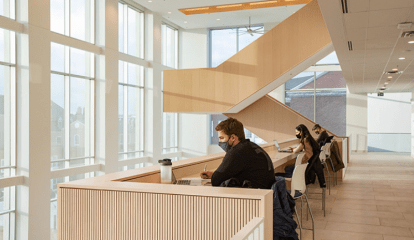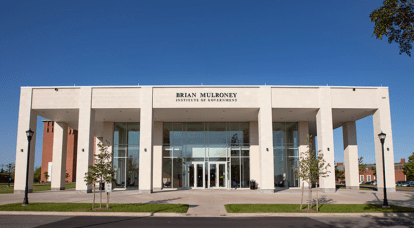
StFX’s Mulroney Hall has been certified LEED® Gold. LEED is an acronym for Leadership in Energy and Environmental Design, a globally recognized environmental building standard that recognizes exceptional commitment to sustainability in design, construction and operation.
When it comes to being green, StFX’s Mulroney Hall is gold—LEED® Gold, that is, a global recognition of its outstanding commitment to sustainability.
Mulroney Hall, the state-of-the-art teaching and research complex that opened in the heart of the StFX campus on September 18, 2019, has achieved LEED Gold (LEED is an acronym for Leadership in Energy and Environmental Design), a globally recognized environmental building standard that recognizes exceptional commitment to sustainability in design, construction and operation.
To achieve LEED Gold, prerequisites and credits are awarded in seven categories including sustainable sites, water efficiency, energy and atmosphere, materials and resources, indoor environmental quality, innovation and design process, and regional priorities.
“Congratulations! LEED Gold reflects the environmental values of former Prime Minister Brian Mulroney, StFX University and its students. It was an honour to work on this exciting project,” says Tim Handforth, retired Facilities Management Project Manager.
“Building performance and campus sustainability holds great importance for StFX and the surrounding community. With any renovation or new construction, we continually seek ways to improve efficiencies through design that promotes effective use of resources, water and energy,” says Luc Venedam, Facilities Management Project Manager.
“Mulroney Hall is an example of the university’s commitment to developing a sustainable campus. The LEED Gold achievement signifies the effort put forth during each phase of the project from design to construction.”
“Moriyama Teshima Architects (MTA) is very proud of Mulroney Hall’s LEED Gold certification by the Canadian Green Building Council,” says architect Mohammed al Riffai.
“As architects, the depth and scale of our design responses to issues surrounding sustainability are primarily driven by mandates from building owners. StFX’s visions of environmental stewardship and aspirations for a highly sustainable future for its campus was clear and resolute, in turn supporting conscientious decision-making throughout the design and construction process.”
He says many technical features were developed for the building, which contributed to this certification; a durable and ultra-performing envelope design, highly intelligent and efficient building systems, and an exacting construction-phase and post-occupancy waste and energy consumption monitoring process.
“Above and beyond the technical accomplishments of the building, MTA is especially proud of how the design enhances the quality of the indoor environment and user experience,” he says. “The architectural design successfully responded to a LEED requirement that all regularly occupied spaces receive a specified amount of daylight, a major challenge in a large and complex building such as this. Through careful spatial planning and analysis, and the layering of occupied spaces across from the large bright and airy spaces of the Joyce Atrium, Scholars’ Walk and the upper campus entrance by the replica Prime Minister’s Office, this daylighting requirement was met.”

From an interior design perspective, he says the design uses durable material choices with high recycled content and zero, or ultra-low, volatile organic emissions, with responsibly sourced wood shaping the key features of the building. The building demonstrates that sustainable spaces are also healthy spaces that contribute to a holistic balance between our personal wellness and that of the environment.
SUSTAINABLE OPERATION IMPORTANT
Mr. Handforth says some of the highlights of the project include a geothermal field on the south side of the building, that combined with a series of heat pumps, keeps the building comfortable year-round and provides significant energy savings. Additionally, all faculty offices have a large window and are located on the south side of the building, and all classrooms have an outside view. The lighting system is 100 per cent controllable in the offices and shared multi-use areas.
Longstanding, sustainable operation of Mulroney Hall was an important consideration throughout the project, from the way waste was managed during construction (over 80 per cent of waste generated was diverted) to incorporating bicycle infrastructure and electric vehicle chargers as part of the project scope, to the landscape, which was designed with native and adaptive plants that perform best in the location.
Mr. Venedam says such conservative practices are visible in many campus buildings, including the dual flush and low flow fixtures in the Schwartz School of Business and the Coady Institute. Other examples are the continuous upgrades to building automation and lighting that operate via scheduling, occupancy sensing equipment along with other sensors that adjust ventilation and light levels providing functional spaces that aim to bring comfort to the occupant(s) while reducing environmental impact and operating costs.

Architect for the Mulroney Hall project was Moriyama & Teshima with Barrie and Langille Architects; Structural Engineer was BMR Structural Engineering; Mechanical and Electrical Consulting Engineers: F.C. O’Neill, Scriven, & Associates; the General Contractor was EllisDon; and the Landscape Architect was Gordon Ratcliffe Landscape Architect.
Sustainable highlight examples from Mulroney Hall include:
• Geothermal energy. A geothermal heat pump system (60 wells were drilled 600 feet into the ground) heats and cools Mulroney Hall and Nicholson Tower, providing a more consistent temperature for improved efficiency compared to air-source heat pumps. The geothermal field is designed to be a reliable, long-term sustainable heating and cooling source.
• Clean construction. Contractors developed and implemented a plan to improve indoor air quality for both during construction and for occupancy. This included numerous factors including HVAC protection, source control, and housekeeping.
• Low emitting materials. Indoor air quality was an important consideration for the building. Volatile organic compounds (VOCs) can be detrimental to human health so Mulroney Hall has incorporated low-emitting paints, adhesives, sealants, flooring, and composite wood throughout to provide better indoor air quality.
• Reducing construction waste. Construction projects can generate much waste. Mulroney Hall’s construction debris was sent to a C&D site where it can be recycled and incorporated into new products. This leads to a more circular economy that reduces waste and conserves resources. Mulroney Hall diverted over 80 per cent of waste generated.
• Recycled materials. Mulroney Hall was built using materials with recycled content wherever possible. This reduces the need to harvest new resources and diverts materials from the waste stream. Many commonly used products are available with recycled content including steel, concrete, masonry, drywall, acoustic tile, carpet, ceramic tile, and insulation.
• Alternative transportation. As part of the project’s scope, three electric vehicle chargers were installed on campus. Bicycle infrastructure was also incorporated into the building including bike racks and shower facilities. Signage was posted to reduce the speed limit on campus, providing safer access to cycling.
• Renewable energy. Mulroney Hall has two solar panel arrays on its rooftops that produce a portion of the building’s electricity needs. Flat roofs like the ones on Mulroney Hall make ideal locations for photovoltaic panels.
• Cool roof. Highly reflective white roofing was used to combat the heat island effect, caused when dark, non-reflective materials absorb heat from the sun and radiate it into the surroundings. Ambient temperatures in urban areas are higher as a result, increasing cooling loads and negatively affecting plants, animals and humans.
• Daylight and views. Mulroney Hall has abundant high-performance windows that capture stunning campus views and flood the building with natural light. Access to views has been shown to increase occupants’ well being and capturing daylight reduces electricity demands. Views to the exterior were an important design consideration.
• Landscaping. The landscaping was designed so it can survive with only rainwater, which eliminates the need for potable water used for irrigation. Hardy native and adapted plant species were selected. Plants native to the area perform better and require less water. They also provide better food and habitat for local birds, insects, and other wildlife. Special care was taken to avoid species of trees and plants considered invasive because they can throw off the natural balance of local ecosystems and block native plants from growing, reducing biodiversity.

